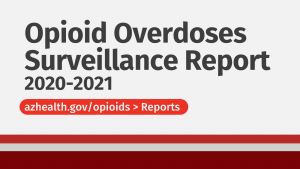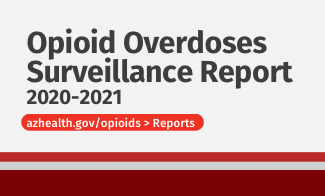 More than 2,000 Arizonans lost their lives to opioid overdoses in 2021, with fentanyl the most commonly reported drug in opioid overdoses.
More than 2,000 Arizonans lost their lives to opioid overdoses in 2021, with fentanyl the most commonly reported drug in opioid overdoses.
You’ll find this and other key information in the just-published Opioid Overdoses Surveillance Report, 2020-2021. Producing this report is just one way ADHS continues to battle a crisis in which five Arizonans die on an average day from synthetic opioids.
In recent years, the challenge of overdose deaths has increasingly shifted from overprescribing to illicitly manufactured fentanyl pills. Fentanyl is the most commonly identified substance in verified opioid overdoses. Just one counterfeit pill can contain a lethal dose.
Other key data points from new report include:
- During 2020 and 2021, rates for opioid overdoses were highest among people ages 25-34 and among men.
- Verified non-fatal opioid overdoses decreased to 3,557 in 2021 from 3,988 in 2020.
- The number of opioid deaths peaked in July 2020 and has leveled off in 2021.
- Heroin deaths decreased 68% from a high of 352 in 2018 to 111 in 2021.
- Rates of opioid deaths were highest in Pima, Maricopa, Yavapai, and Gila counties during 2020 and 2021.
- In 2021, there were more than 52,000 opioid-related hospitalizations and emergency department visits in Arizona costing a total of $2.2 billion.
- More than 9 Arizonans a day experience non-fatal opioid overdoses.
- There has been a 30% reduction in the number of opioid pills dispensed in Arizona since 2018.
More data can be found on our opioid dashboard.
ADHS has important resources available to address the opioid crisis.
The Opioid Assistance and Referral Line (OARLine), launched in 2018 in partnership with Arizona’s poison and drug information centers, provides health care clinicians with free consultations on patients with complex pain or opioid use disorder. It also provides information and referrals to the public and conducts follow-up with people experiencing overdoses. Its free services are available at 888-688-4222.
ADHS makes naloxone available at no cost to law enforcement agencies, county health departments, hospital and medical center emergency departments, community-based organizations such as substance use prevention coalitions, harm reduction organizations, and family and homeless shelters. Organizations can access naloxone through some county health departments serving as naloxone hubs, or through the naloxone page on the azdhs.gov/opioid website.
Individuals can also access naloxone through pharmacies in Arizona thanks to a standing order issued by our medical director. Pharmacies have significantly increased the dispensing of naloxone since 2017, and now issuing more than 4,000 naloxone prescriptions per month. This year alone, naloxone has been administered more than 5,000 times to people experiencing an overdose in Arizona and has been used in an estimated 80% of non-fatal opioid overdose responses.
ADHS is distributing fentanyl test strips through many county health departments thanks to $100,000 made available through federal grants. Fentanyl test strips have been shown to be highly sensitive and effective at detecting the presence of fentanyl in drug samples. Organizations working with people at high risk of an overdose can order fentanyl test strips by emailing [email protected]
Each of us has a role in reducing opioid overdose deaths. If you have or consider yourself at risk for opioid use disorder, please call 888-688-4222 to take advantage of the OARLine’s free services. Or check out AHCCCS’s Opioid Services Locator to find available treatment. Have naloxone on hand if you have a family member or friend at risk of an overdose.
Understanding the opioid crisis is one of the keys to fighting it. With that in mind, I hope you’ll take some time to review this latest report. And if you know someone who is or might be affected by opioids, please start a conversation. It can save a life.










